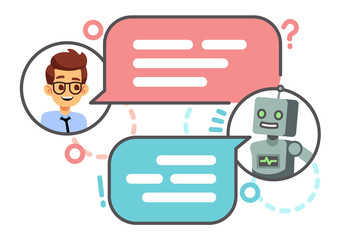“Don’t blame me. I’m an interpreter. I’m not supposed to know a power socket from a computer terminal.” You might be more used to Yoda’s wisdom, but when it comes to chatbots, it’s C3PO who can teach us a thing or two.
All too often, discussion about chatbots focuses on AI, and to an extent that makes sense. AI is the futuristic-sounding shiny thing that offers a new hope that sci-fi is finally meeting reality. Yet the power of chatbots rests on something altogether more basic – the available information. Chatbots only interpret information so if a user has a bad experience with a chatbot, the information the chatbot has access to needs a closer look. Chatbots, and by extension the inbuilt AI, are nothing without information.
The history of the chatbot: Where it was and where it’s going
Putting information at the heart of the chatbot
Picture this. You’re at a party. You know how to have a conversation. But you just don’t know what to talk about. Nothing you say interests the person you’re talking to. The awkward conversation rumbles on until it comes to an uncomfortable close.
This is exactly what’s happening when a chatbot is firing inappropriate responses or questions at a user. The chatbot doesn’t have the right information to have a useful conversation with the user. It’s not the how to have a conversation element that has slipped. It’s the inability to find the right information – and that’s why information needs to be at the heart of every chatbot project.
Information leads to intelligence
To get the strategy right, it helps to build your chatbot processes around two tiers. First, the chatbot starts the conversation, gets presented with a question, and tries to find the answer in the data it has available, then that answer is sent back to the users. Now here’s where the second tier comes in – and this is the real mark of a good chatbot – if the chatbot can’t find the answer, it dispatches the query to a human being. The human being then figures out the answer and passes it back to the chatbot. Crucially, the chatbot learns from that interaction, and gains additional knowledge about its world.
This means the service provided by the chatbot, and in turn the user experience, can be continually improved.
Fidor partners with Finn AI to launch an AI-powered chatbot for banks
Improving the user experience to improve the bottom line
Once you’ve got the basics running smoothly, chatbots can be used across your organisation’s online presences — whether that’s the website, social media or apps. Here is where the chatbot can really prove its muscle. Chatbots are being increasingly used by the digital commerce industry, as they can be a powerful way to mimic a personalised in-store purchasing journey in the online world.
They can answer queries, find the right product, and even close a sale. Yet in all of this, it’s the experience that’s vital. Chatbots will explode as a primary digital commerce tool, but the winners will be those who make it easy for the user to find the right information. Nowadays, consumers expect customisation, and having chatbots that retain and learn from past information will be vital.
What’s more, a user’s interactions with an organisation, retailer or brand should be the same regardless of where that interaction is taking place. Chatbots simply offer more possibilities for input, questions and answers. When those conversations are taking place on familiar platforms, the proposition becomes even more powerful. If someone is chatting away to friends on Messenger, for example, it can feel natural to ask a brand questions, get the answers you’re after … and eventually make a purchase.
If the experience feels natural, the purchase will feel natural too.
Chatbot implementation: Best practice tips from Avanade
Connecting the chatbot to your brand
The best way to think about chatbots is that they help your users interact with information. If you provide second-rate information, they’ll get second-rate answers. That’s clearly not a good recipe for connecting the chatbot to your brand. Again, the information the chatbot has access to is key.
Feeding the chatbot with information about how your brand wants to talk to users or customers, helping it get your tone of voice right, ensuring all basic queries can be answered, and ensuring a human can provide input on any previously unanswerable questions are all vital. AI might improve a chatbot, but it alone cannot power it. This all comes back to information, access to that information, and the ability to learn new information.








